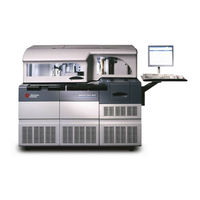Beckman Coulter UniCel DxC 800 Manuals
Manuals and User Guides for Beckman Coulter UniCel DxC 800. We have 2 Beckman Coulter UniCel DxC 800 manuals available for free PDF download: Instructions For Use Manual, Daily Start Up
Beckman Coulter UniCel DxC 800 Instructions For Use Manual (499 pages)
UniCel DxC Synchron
Clinical Systems
Brand: Beckman Coulter
|
Category: Medical Equipment
|
Size: 20.52 MB
Table of Contents
-
-
Introduction33
-
-
Clearances38
-
Drain38
-
DXC Systems41
-
-
Sample Racks43
-
Pushers46
-
Sample Gate46
-
-
Sample Log75
-
-
Beer's Law90
-
-
-
-
Overview99
-
Password Setup100
-
-
Date/Time Setup111
-
Panels113
-
Replicates114
-
Report Setup114
-
Bar Code Setup123
-
Printer Setup128
-
Service Setup128
-
Version Upgrade129
-
Chemistry Update130
-
-
-
Reagent Carousel142
-
Enzyme Validator155
-
Chemistry Bypass157
-
-
Define a Control168
-
Delete a Control176
-
Print QC Ranges177
-
QC File List178
-
QC Summary179
-
QC Log182
-
Archive QC187
-
-
Overview191
-
-
Rack Status193
-
Identify Samples194
-
Clear Samples202
-
-
-
Overview205
-
-
Recall Data212
-
Send Data212
-
-
-
-
Overview215
-
-
Reaction Type218
-
Precision219
-
Units219
-
Math Model220
-
-
Blank Read Times225
-
Sample Volume225
-
-
Multipoint Spans228
-
-
Option 1230
-
Summary230
-
Calibration231
-
-
-
Option 2231
-
Wavelengths231
-
Blanking232
-
Measurement232
-
Volumes232
-
-
Cal Save234
-
-
Ordac235
-
Maintenance237
-
-
Utilities
237-
Chassis Ground238
-
Feature Summary240
-
Help241
-
Procedure241
-
Clean Mixers267
-
ISE Service290
-
Action Log300
-
Clean the Blade357
-
-
-
Show Cycle Count366
-
Counters367
-
Temperatures367
-
Power Subsystems368
-
CTS Tracking371
-
Home372
-
Why Use Home372
-
Pause373
-
Shutdown376
-
ON/OFF Switch377
-
Full Boot378
-
After Boot-Up379
-
Pause Waste B379
-
Reset379
-
Resume Waste B380
-
Disable Modules381
-
Enable Modules381
-
Unload All382
-
Unload All Racks383
-
-
Accessing Prime386
-
Stopping a Prime387
-
Event Log390
-
Maintenance390
-
Show Events392
-
Copy to a Disk393
-
Clear Events395
-
Metering396
-
Modem396
-
Reagent Metering396
-
Alignment Data397
-
Backup/Restore397
-
Parallax400
-
Index401
-
Contents411
-
-
Back-To-Back418
-
MC Calibration418
-
Dac419
-
Span420
-
Multipoint Span426
-
Recovery426
-
Math Errors427
-
Sensitivity427
-
Severe Recovery427
-
Result Errors429
-
Backup/Restore479
-
Advertisement
Beckman Coulter UniCel DxC 800 Daily Start Up (15 pages)
Synchron Clinical System
Brand: Beckman Coulter
|
Category: Laboratory Equipment
|
Size: 0.57 MB
Table of Contents
-
Calibrate11
Advertisement
Related Products
- Beckman Coulter UniCel DxC 600
- Beckman Coulter UniCel DxC 600i
- Beckman Coulter DxC 600i
- Beckman Coulter UniCel DxC 660i
- Beckman Coulter UniCel DxC 680i
- Beckman Coulter UniCel DxC 860i
- Beckman Coulter UniCel DxC 880i
- Beckman Coulter DxC 700 AU
- Beckman Coulter UniCel DxH 800
- Beckman Coulter DU 600 Series

